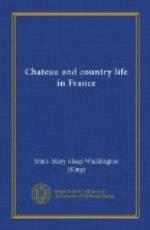We went home by a different road, but it looked just like the other—fewer little hamlets, perhaps, and great pasture fields, filled with fine specimens of Norman dray horses and mares with long-legged colts running alongside of them. It was late when we got home. The lighthouses of Honfleur and Havre made a long golden streak stretching far out to sea, and the great turning flashlight of St. Adresse was quite dazzling.
We went back over the same ground two or three days later on our way to Bayeux. The town is not particularly interesting, but the cathedral is beautiful and in wonderful preservation—the columns are very grand—every capital exquisitely carved and no two alike. Our guide, a very talkative person—unlike the generality of Norman peasants, who are usually taciturn—was very anxious to show us each column in detail and explain all the really beautiful carving, but we were rather hurried as some of the party were going to lunch at Barbieville—Comte Foy’s chateau.
On the same place as the cathedral is the Hotel de Ville, with the wonderful tapestries worked by the Queen Mathilde, wife of William the Conqueror. They are really most extraordinary and so well preserved. The colours look as if they had been painted yesterday. I hadn’t seen them for years and had forgotten the curious shapes and vivid colouring. We went to one of the lace shops. The Bayeux lace is very pretty, made with the “fuseau”, very fine—a mixture of Valenciennes and Mechlin. It is very strong, though it looks delicate. The dentellieres still do a very good business. The little girls begin to work as soon as they can thread their needle, and follow a simple pattern.
* * * * *
The F.’s enjoyed their day at Barbieville, Comte Foy’s chateau, very much. They said the house was nothing remarkable—a large square building, but the park was original. Comte Foy is a racing man, breeds horses, and has his “haras” on his place. The park is all cut up into paddocks, each one separated from the other by a hedge and all connected by green paths. F. said the effect from the terrace was quite charming; one saw nothing but grass and hedges and young horses and colts running about. Comtesse Foy and her daughters were making lace. The girls went in to Bayeux three or four times a week and took lessons from one of the dentellieres.
XI
BOULOGNE-SUR-MER
One year we were at Boulogne for the summer in a funny little house, in a narrow street just behind the port and close to the Casino and beach. There were a great many people—all the hotels full and quantities of automobiles passing all day. The upper part of the town is just like any other seaside place—rows of hotels and villas facing the sea—some of the houses built into the high green cliff which rises steep and almost menacing behind. Already parts of the cliff have crumbled away in some place and the proprietors of the villas find some difficulty in letting them. The front rooms on the sea are charming, but the back ones—directly under the cliff—with no air or sun, are not very tempting. There is a fine digue and raised broad walk all along the sea front, with flowers, seats, and music stand.




